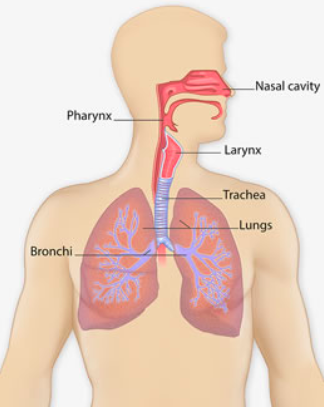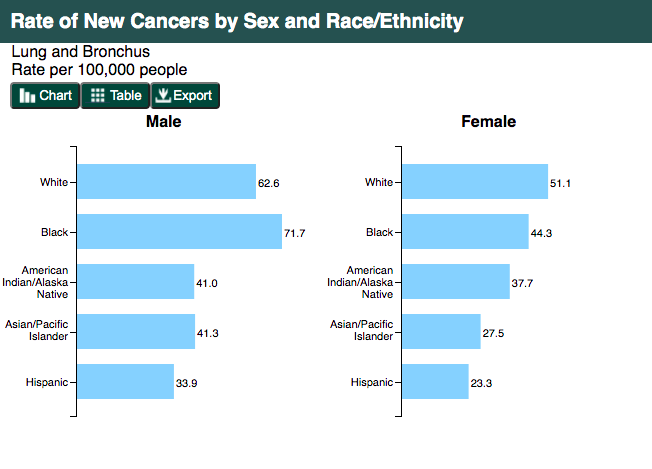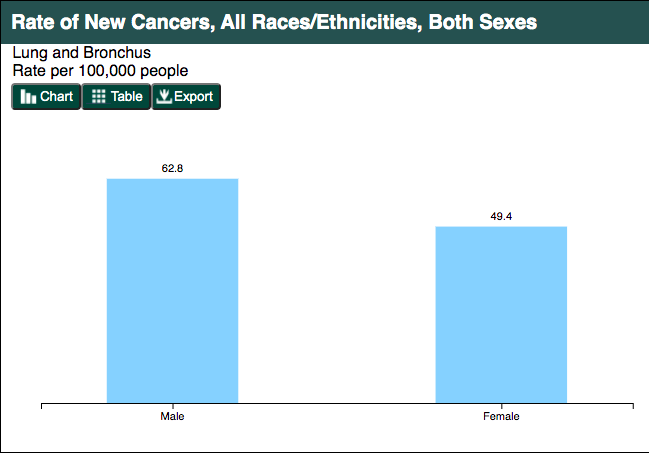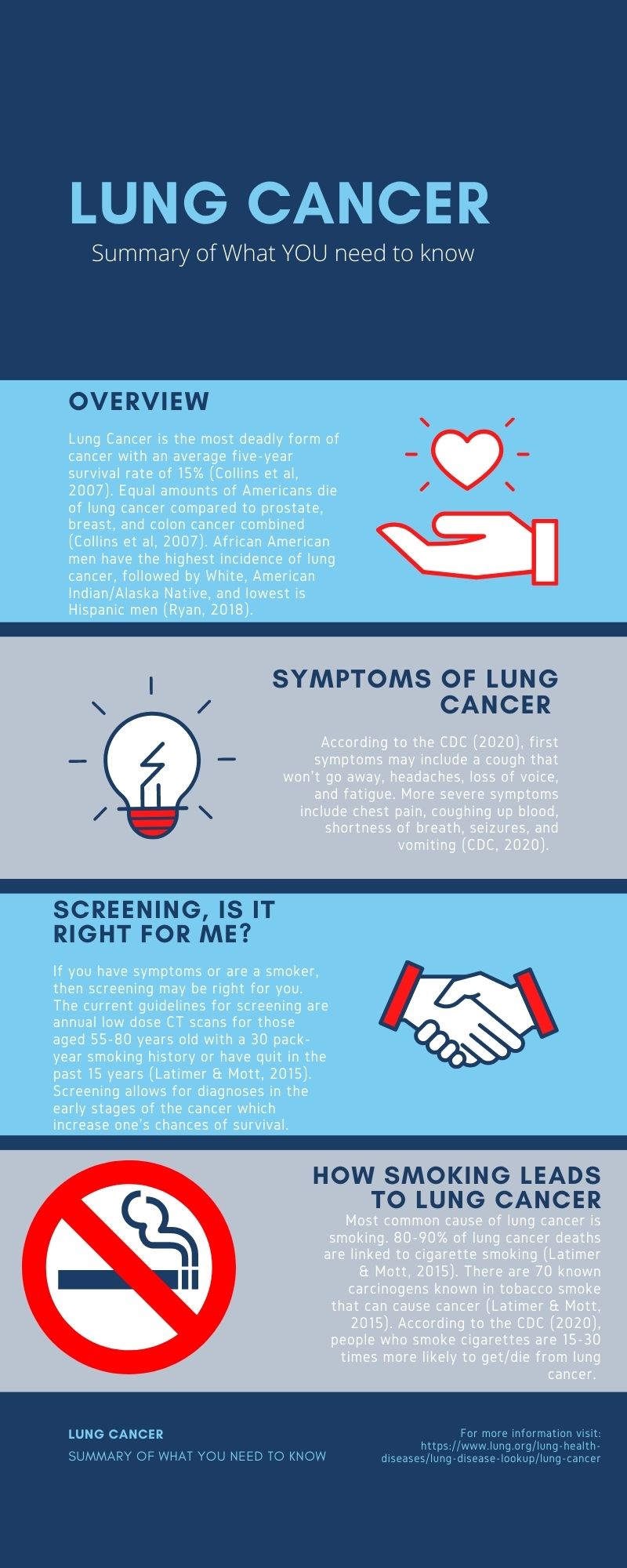17 Lung Cancer
Tanner Huyck
Introduction
Lung cancer is a form of cancer that begins in the lungs. The lungs are spongy organs that take in oxygen and release carbon dioxide (Mayo Clinic, 2020). When humans inhale, oxygen is taken into the bloodstream where it is carried throughout the body and is traded for carbon dioxide which is a waste gas that is released when exhaled. There is a right lung and a left lung that are divided into segments called lobes. Once air enters into the lungs, it travels down branches that decrease in size starting with the bronchus and the end is the alveoli.

The alveoli are tiny air sacs where oxygen is exchanged for carbon dioxide (American Lung Association, 2020). The lungs are very important to the human body as they help humans breathe, but the presence of lung cancer makes it very difficult for the lungs to work properly.
Symptoms and Diagnosis
Most people with lung cancer do not show symptoms in the early stages but as the cancer advances, symptoms start to appear. They may seem small at first such as a cough that won’t go away, headaches, loss of voice, and fatigue (CDC, 2020). More extreme symptoms are chest pain, coughing up blood, shortness of breath, unintended weight loss, seizures, and vomiting (CDC, 2020). When diagnosing patients, there are two different types of lung cancer; small cell lung cancer (SCLC) and non-small cell lung cancer (NSCLC). Non-small cell lung cancer is further divided into adenocarcinoma, squamous cell carcinoma, and large cell carcinoma (Collins et al., 2007). Non-small cell lung cancers account for 85% of lung cancer with small cell lung cancers accounting for 15% of lung cancers (Collins et al., 2007). Specifically, adenocarcinoma is the most common type of lung cancer compromising 38.5% of all lung cancers (Collins et al., 2007). The different lung cancer categories help doctors during diagnosis and treatment (Dela Cruz et al., 2011). African American men are the most susceptible to lung cancer compared to other ethnicities as the age-adjusted rate is 32% higher (Ryan, 2018). Hispanic men have the lowest incidence followed by American Indian/Alaska Native then Non-Hispanic White and African American men with the highest incidence (Ryan, 2018).


How Smoking Leads to Lung Cancer
Lung cancer is the most deadly form of cancer as the average five-year survival rate is around 15 percent (Collins et al., 2007). There are equal amounts of Americans that die of lung cancer compared to prostate, breast, and colon cancer combined (Collins et al., 2007). The most common cause of lung cancer is smoking as about 80-90% of lung cancer deaths are linked to cigarette smoking. This is mainly due to the fact that there are 70 known carcinogens in tobacco smoke. According to the Center for Disease Control and Prevention (2020), “people who smoke cigarettes are 15 to 30 times more likely to get lung cancer or die from lung cancer than people who do not smoke”. Men are especially at risk as they begin to smoke at an earlier age and for a longer duration than women (Visbal et al., 2004). Breathing in secondhand smoke from other people’s tobacco smoke also increases one’s risk for lung cancer. Occupational hazards such as radon, asbestos, arsenic, and diesel exhaust exposure increase one’s risk for lung cancer (CDC, 2020). These are common chemicals found in everyday activities such as cars, trucks, and houses that contain carcinogens which can lead to the formation of cancer when inhaled.
According to Collins et al. (2007), “the most important step in preventing lung cancer is smoking cessation”. Quitting smoking and prevention strategies have proven to be the most effective in decreasing lung cancer (Dela Cruz et al., 2011). The most effective types of quitting smoking treatments are nicotine replacement, counseling, social support, and other medications. Limiting any exposure to smoking such as never smoking, quitting, and avoiding secondhand smoke is very important to preventing lung cancer. Another preventative step is to take precautions to protect oneself from exposure to toxic chemicals at work and home such as asbestos and radon (American Lung Association, 2020).
Screening
Lung cancer screening remains a much debated topic as it has yet to prove that it decreases lung cancer deaths. Lung cancer screening has led to overdiagnosis, unnecessary anxiety, and high costs. There is not enough evidence to prove its overall effectiveness but it has shown to find early cases of lung cancer (Collins et al., 2007). The current guidelines for screening as supported by the U.S. Preventative Services Task Force (USPSTF) is annual low dose CT scans for patients aged 55 to 80 years old and with a 30 pack-year history (have smoked a pack of cigarettes a day for 30 years) or who have quit within the past 15 years (Latimer & Mott, 2015). The reason for the debate stems from the lack of knowledge regarding the long-term hazards from cumulative radiation exposure. There is a risk to be taken during the screening process and often times if lung cancer is found, it is difficult to treat. Due to the differences in guidelines and opinions, conversations with physicians and other health care workers must be had before considering lung cancer screening (Latimer & Mott, 2015).
Treatment
Treatment of lung cancer depends on the type of cancer, stage, and patient history. Overall staging of lung cancer is dependent upon the size of the tumor found and if it has spread to other organ systems. The smaller the tumor and less spread to other organs are reflected in a lower stage. Stage I is the lowest and stage IV is the highest and most severe. Stages I-III are considered local stages while stage IV and some aspects of stage III are considered advanced (Collins et al., 2007). The three most common types of lung cancer treatment consist of surgery, chemotherapy, and radiation therapy. Surgery is the primary treatment for patients with earlier stage lung cancer (stages I-III). Often times surgery will be followed up with rounds of chemotherapy and radiation based upon the progression of the cancer. For small cell lung cancer, chemotherapy and radiation are the most recommended treatments. For non small-cell lung cancer, minimally invasive surgery is recommended with chemotherapy and radiation to follow if needed. For the best outcome, a team of specialists including but not limited to a medical oncologist, radiation oncologist, pathologist, radiologist, and thoracic surgeon must be consulted related to lung cancer (Latimer & Mott, 2015).

Chapter Review Questions
1. What ethnicity is most susceptible to lung cancer compared to other ethnicities?
A. Hispanic
B. White
C. African American
D. American Indian/Alaska Native
2. Which of the following smoking cessation treatments has been found to be least effective?
A. Nicotine Replacement
B. Cold Turkey
C. Counseling and Social Support
D. Medication
3. What is the most common type of lung cancer?
A. Adenocarcinoma
B. Squamous Cell Carcinoma
C. Small Cell Lung Cancer
D. Large Cell Carcinoma
References
American Lung Association. (2020, April 2). How lungs work. https://www.lung.org/lung-health-diseases/how-lungs-work
Centers for Disease Control and Prevention. (2020, September 22). Lung cancer: what are the risk factors. https://www.cdc.gov/cancer/lung/basic_info/risk_factors.htm
Collins, L. G., Haines, C., Perkel, R., & Enck, R. E. (2007). Lung cancer: diagnosis and management. American Family Physician, 75(1), 56–63. Retrieved from https://www.aafp.org/afp/2007/0101/p56.html
Dela Cruz, C. S., Tanoue, L. T., & Matthay, R. A. (2011). Lung cancer: epidemiology, etiology, and prevention. Clinics in Chest Medicine, 32(4), 605–644. https://doi.org/10.1016/j.ccm.2011.09.001
Latimer, K. M., & Mott, T. F. (2015). Lung cancer: diagnosis, treatment principles, and screening. American Family Physician, 91(4), 250-256. Retrieved from https://www.aafp.org/afp/2015/0215/p250.html
Mayo Clinic. (2020, October 10). Lung cancer. https://www.mayoclinic.org/diseases-conditions/lung-cancer/symptoms-causes/syc-20374620
Ryan B. M. (2018). Lung cancer health disparities. Carcinogenesis, 39(6), 741–751. https://doi.org/10.1093/carcin/bgy047
Visbal, A. L., Williams, B. A., Nichols III, F. C., Marks, R. S., Jett, J. R., Aubry, M. C., Edell, E. S., Wampfler, J. A., Molina, J. R., & Yang, P. (2004). Gender differences in non–small-cell lung cancer survival: an analysis of 4,618 patients diagnosed between 1997 and 2002. The Annals of Thoracic Surgery, 78(1), 209-215. http://doi.org/10.1016/j.athoracsur.2004.01.010
either of the two primary divisions of the trachea that lead respectively into the right and the left lung. Bronchial tube and bronchioles are subsets of the bronchus.
a small air-containing compartment of the lungs in which the bronchioles terminate and from which respiratory gases are exchanged with the pulmonary capillaries.
rate of occurrence or influence
a substance or agent causing cancer
a heavy radioactive gaseous element formed by the decay of radium
any of several minerals (such as chrysotile) that readily separate into long flexible fibers, that have been implicated as causes of certain cancers, and that have been used especially formerly as fireproof insulating materials
a solid chemical element that is used especially in wood preservatives, alloys, and semiconductors and is extremely toxic in both pure and combined forms
the fact or process of ending or being brought to an end
the administration of one or more cytotoxic drugs to destroy or inhibit the growth and division of malignant cells in the treatment of cancer
type of cancer treatment that uses beams of intense energy to kill cancer cells
physician concerned with the prevention, diagnosis, treatment, and study of cancer
physician concerned with the prevention, diagnosis, treatment, and study of cancer utilizing radiation therapy.
a physician who interprets and diagnoses the changes caused by disease in tissues and body fluids
physician specializing in medical radiology.
medical specialist who practices surgery related to the chest.

